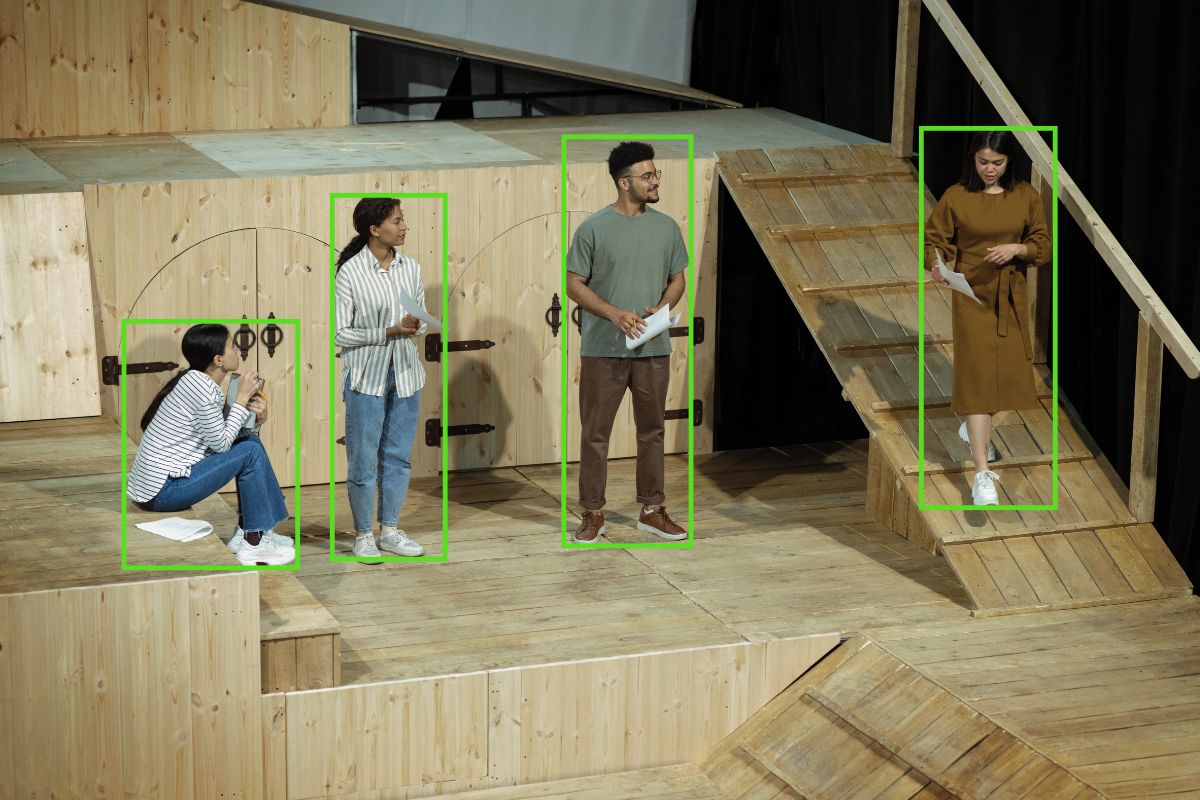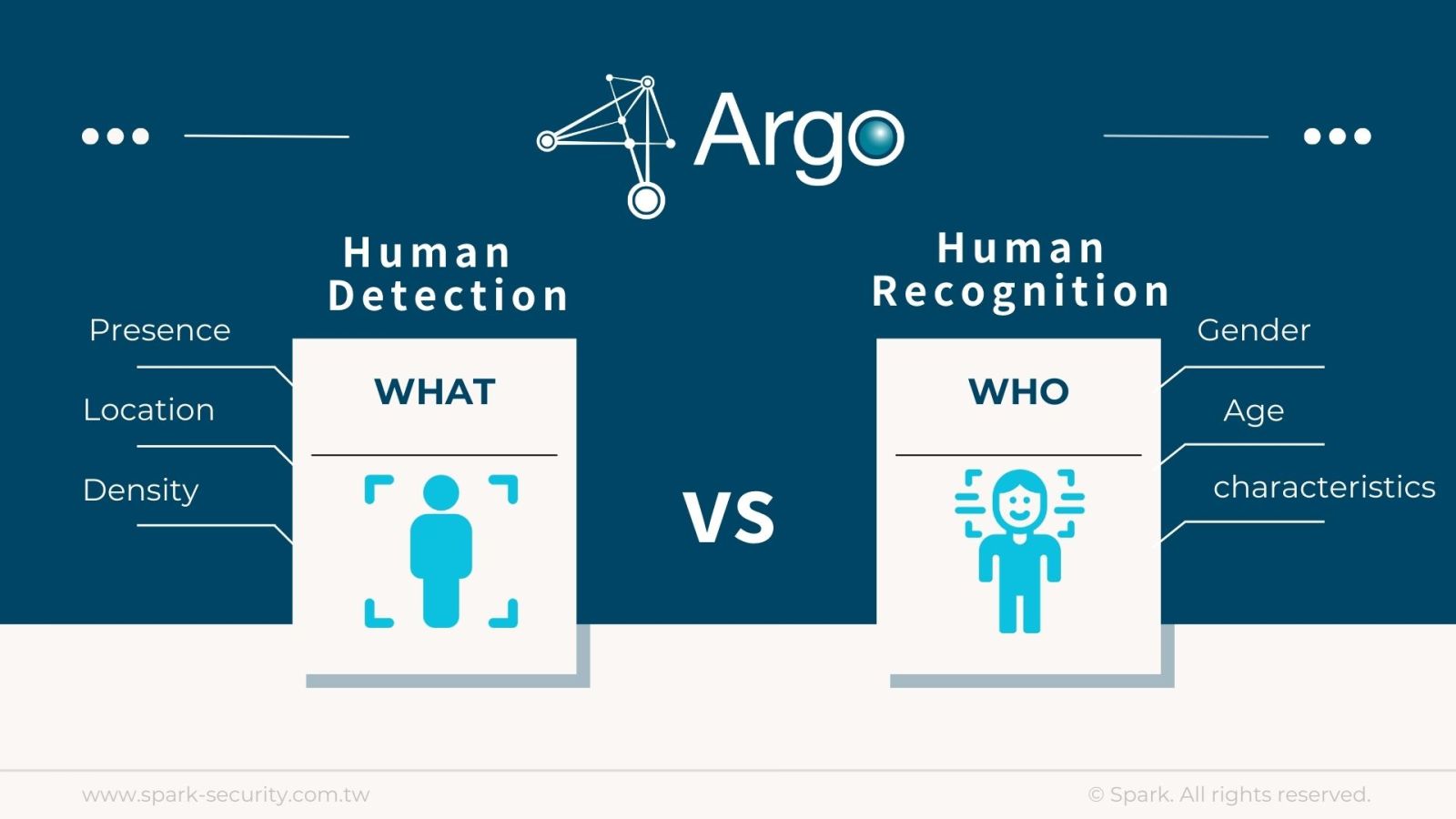2024.12.19
AI technology advances have made human detection and recognition vital in computer vision, serving distinct purposes in identifying shapes and individuals.
AI Human Detection
AI human detection uses technology to identify and locate human shapes in images or videos through methods like sliding windows or convolutional neural network "CNN", marking locations with bounding boxes.

-
Key Features
|
Automated Detection |
AI human detection identifies shapes in images without human input. |
||||||||||||||||||||||||||
|
High Accuracy |
AI models achieve high accuracy through extensive training, enhancing performance in complex scenarios. |
||||||||||||||||||||||||||
|
Versatility |
Spark's AI detection also aids in pedestrian tracking and alert zones. |
||||||||||||||||||||||||||
-
AI Human Detection Functions
|
Object Detection |
Identifying the presence and location of human shapes in images or videos, commonly used in environmental monitoring and traffic management. |
||||||||||||||||||||||||||
|
Stay Detection |
Tracking specific human shapes or detecting humans within a space or monitoring area, applicable in factory management, security systems, and intelligent traffic management. |
||||||||||||||||||||||||||
|
Density Detection |
Tracking how many people are within a space or monitoring area, applicable in exhibition environments and amusement parks. |
||||||||||||||||||||||||||
AI Human Recognition
AI human recognition identifies specific individuals by comparing features like facial attributes, gender, age, and body characteristics.
It requires initial human detection, which involves identifying human shapes, analyzing their features and behaviors, and matching these against a database for confirmation.
 (Source:Freepik )
(Source:Freepik )
-
AI Human Recognition Functions
|
Face Recognition |
By analyzing human features or facial characteristics, the identity, gender, or age of a person can be confirmed, applied in security verification or access control systems. |
|||||||||||||||||||||||||||
|
Cross-Line Recognition |
Rapid recognition is conducted in a space or monitoring area by crossing lines, enabling statistical counting and population control. |
|||||||||||||||||||||||||||
|
Specific Identity Recognition |
Identified personal information provides tailored services, such as site safety (hard hat detection). |
|||||||||||||||||||||||||||
|
Advanced Behavior Recognition |
Drowning detection, fall detection. |
|||||||||||||||||||||||||||
Human Detection vs. Human Recognition: Key Differences
1.Difference in Purpose
Human detection confirms the presence and location of people in images, while recognition identifies individuals, useful in security and access control.
2.Technical Differences
Human detection uses simpler models, while recognition relies on complex deep learning for accurate feature identification.
3.Difference in Application
Human detection is used in security and monitoring for real-time alerts, while human recognition manages identities in attendance and access control systems.

In summary, human detection identifies individuals' presence and location, while human recognition confirms their identities. Both are essential for effective security and identity management in surveillance systems. For enhanced security and efficiency, contact us.
AI technology advances have made human detection and recognition vital in computer vision, serving distinct purposes in identifying shapes and individuals.
AI Human Detection
AI human detection uses technology to identify and locate human shapes in images or videos through methods like sliding windows or convolutional neural network "CNN", marking locations with bounding boxes.

-
Key Features
|
Automated Detection |
AI human detection identifies shapes in images without human input. |
||||||||||||||||||||||||||
|
High Accuracy |
AI models achieve high accuracy through extensive training, enhancing performance in complex scenarios. |
||||||||||||||||||||||||||
|
Versatility |
Spark's AI detection also aids in pedestrian tracking and alert zones. |
||||||||||||||||||||||||||
-
AI Human Detection Functions
|
Object Detection |
Identifying the presence and location of human shapes in images or videos, commonly used in environmental monitoring and traffic management. |
||||||||||||||||||||||||||
|
Stay Detection |
Tracking specific human shapes or detecting humans within a space or monitoring area, applicable in factory management, security systems, and intelligent traffic management. |
||||||||||||||||||||||||||
|
Density Detection |
Tracking how many people are within a space or monitoring area, applicable in exhibition environments and amusement parks. |
||||||||||||||||||||||||||
AI Human Recognition
AI human recognition identifies specific individuals by comparing features like facial attributes, gender, age, and body characteristics.
It requires initial human detection, which involves identifying human shapes, analyzing their features and behaviors, and matching these against a database for confirmation.
 (Source:Freepik )
(Source:Freepik )
-
AI Human Recognition Functions
|
Face Recognition |
By analyzing human features or facial characteristics, the identity, gender, or age of a person can be confirmed, applied in security verification or access control systems. |
|||||||||||||||||||||||||||
|
Cross-Line Recognition |
Rapid recognition is conducted in a space or monitoring area by crossing lines, enabling statistical counting and population control. |
|||||||||||||||||||||||||||
|
Specific Identity Recognition |
Identified personal information provides tailored services, such as site safety (hard hat detection). |
|||||||||||||||||||||||||||
|
Advanced Behavior Recognition |
Drowning detection, fall detection. |
|||||||||||||||||||||||||||
Human Detection vs. Human Recognition: Key Differences
1.Difference in Purpose
Human detection confirms the presence and location of people in images, while recognition identifies individuals, useful in security and access control.
2.Technical Differences
Human detection uses simpler models, while recognition relies on complex deep learning for accurate feature identification.
3.Difference in Application
Human detection is used in security and monitoring for real-time alerts, while human recognition manages identities in attendance and access control systems.

In summary, human detection identifies individuals' presence and location, while human recognition confirms their identities. Both are essential for effective security and identity management in surveillance systems. For enhanced security and efficiency, contact us.


